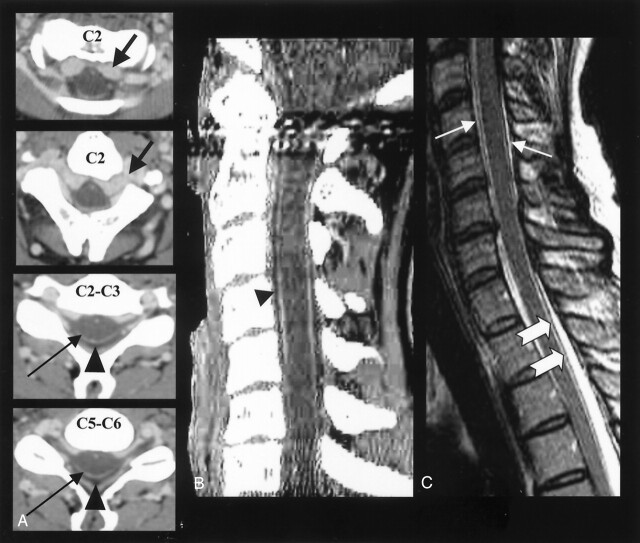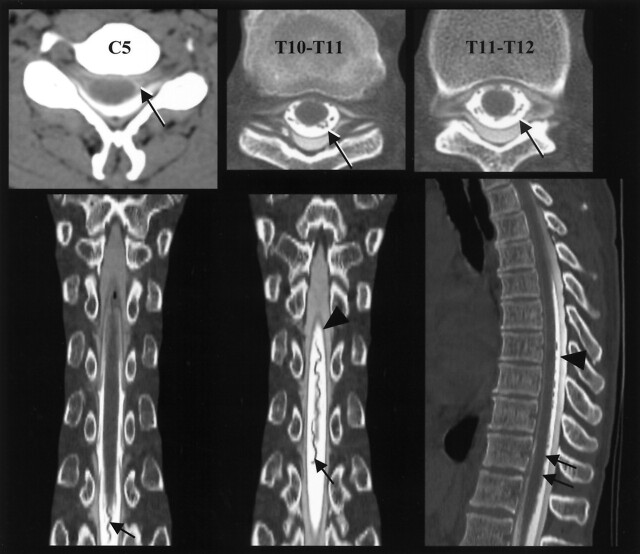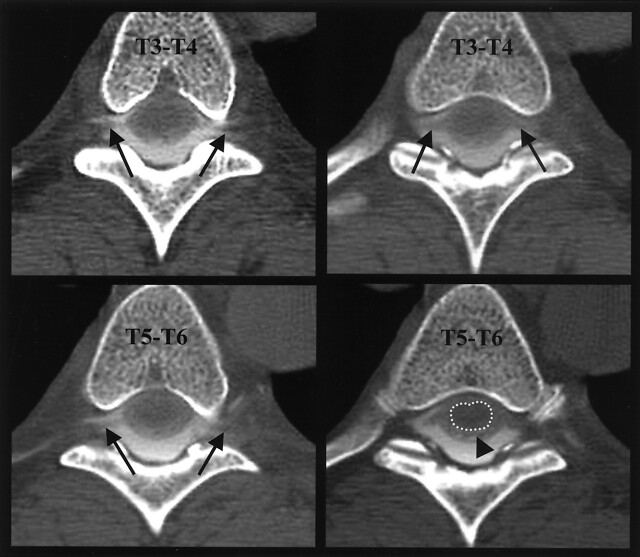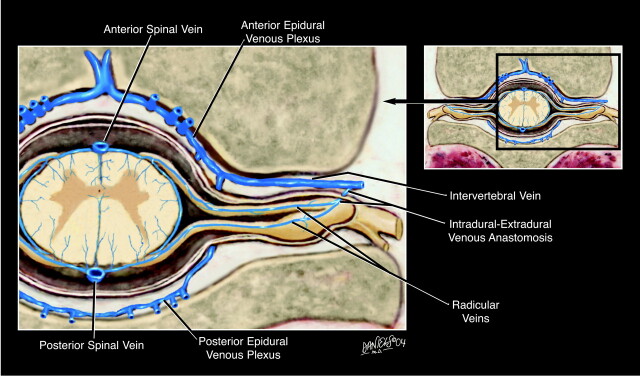Abstract
Summary: We present a case of craniospinal hypotension in a 45-year-old woman with an associated epidural pseudomeningocele extending the entire length of the spine. The epidural pseudomeningocele was caused by a CSF leak at the T8 level. In addition to typical low-pressure symptoms, the epidural pseudomeningocele caused atypical symptoms characterized by positional thoracic radiculopathy. Craniospinal hypotension was associated with massive cervical epidural venous engorgement, as well as enlargement of the posterior spinal cord vein, which was reminiscent of a dural arteriovenous fistula at CT myelography. Enlargement of the posterior spinal vein is explained by the Monro-Kellie hypothesis, and the spinal analog to enlarged cerebral veins known to be associated with intracranial hypotension.
Since its initial description in 1938 (1, 2), the syndrome of intracranial hypotension has been recognized as a cause of orthostatic cephalalgia. The most common causes of reduced CSF pressure leading to intracranial hypotension include persistent CSF leakage from lumbar puncture, spontaneous CSF leakage, or excessive CSF drainage (3). Although the syndrome is well recognized, the varying clinical presentations and imaging features of intracranial hypotension continue to be elucidated (4–8). We present a patient with craniospinal hypotension with the unusual clinical presentation of positional thoracic radiculopathy whose imaging revealed a spinal epidural pseudomeningocele as well as a dilated posterior thoracic spinal cord vein that was reminiscent of a dural arteriovenous fistula (AVF).
Case Report
A 45-year-old woman with a history of idiopathic thrombocytopenia and chronic left chest wall pain presented to our institution for a second opinion regarding a presumptive diagnosis of Erdheim-Chester disease. The patient had initially presented 10 months earlier to an outside institution with sudden-onset neck pain, severe meningismus, and headache. At the time of her initial workup, lumbar puncture revealed normal CSF and excluded meningitis as the cause of her symptoms. The only other prior spinal procedure that the patient had undergone was epidural anesthesia years earlier for delivery of two children. Initial conventional radiographs and MR imaging revealed calcium hydroxyapatite deposition disease and edema of the longus colli muscle fascia, respectively. With steroid and cholchicine therapy, the acute prevertebral fasciitis improved and the associated imaging findings resolved.
Three months after her initial presentation, the patient was reevaluated at another institution for persistent headache and neck pain, exacerbated by Valsalva maneuvers. The headaches had become intense and were localized to the right occipital region, radiating bilaterally to her neck and shoulders. Other symptoms included nausea, vomiting, upright positional ear pressure, photophobia, phonophobia, and intermittent left-arm numbness. Chronic rib and chest pain were compounded by left T5–T8 dermatomal chest wall pain, exacerbated by supine position. The left chest wall pain had in the interval between her initial presentation and this presentation caused several trips to the emergency room to rule out cardiac disease. At these visits, full cardiac workups did not reveal myocardial ischemia or infarction.
The patient never exhibited convincing signs of myelopathy or thoracic radiculopathy, and her neurologic examination remained otherwise normal. MR imaging to evaluate her persistent symptoms revealed an enhancing cervical epidural mass that was new compared with the MR image obtained 3 months earlier. On the basis of imaging and laboratory findings, the patient was given the provisional diagnosis of Erdheim-Chester disease, a variant of histiocytosis, and an epidural biopsy was recommended to confirm the diagnosis. At the same time, engorged epidural veins thought to be secondary to vasculitis or venous thrombosis, were noted.
Before proceeding with further workup, the patient sought a second opinion at our institution. Contrast-enhanced CT and MR images of the cervical spine were obtained. They showed a dilated cervical epidural venous plexus (not a solid mass as suggested previously), spinal dural enhancement, and a cervicothoracic epidural fluid collection with imaging characteristics similar to those of CSF (Fig 1). The epidural fluid collection caused effacement of the thecal sac and was consistent with an epidural pseudomeningocele caused by a CSF leak. Other findings noted at MR imaging included posterior fossa dural and tentorial enhancement, moderately enlarged pituitary gland, and decreased size of the prepontine and medullary cisterns.
Fig 1.
Cervicothoracic epidural pseudomeningocele with dilated cervical epidural venous plexus and spinal dural enhancement.
A, Contrast-enhanced axial CT scan demonstrates dilated cervical epidural venous plexus (black arrows), an epidural fluid collection (black arrowheads), and spinal dural enhancement (long arrows).
B, Sagittal reformatted CT images of the cervical spine demonstrates further the epidural fluid collection (black arrowheads) and dural enhancement.
C, Sagittal T2-weighted MR image of the cervical spine shows the epidural fluid collection (thin white arrows) and a cervicothoracic posterior dural margin (thick white arrows).
CT myelography of the cervical and thoracic spine further characterized the spinal abnormalities. CSF opening pressure was measured at 80 mm H2O (normal, 80–120 mm H2O). CT myelography revealed a large epidural CSF collection spanning the entire cervical and thoracic spine (Fig 2). MR imaging of the lumbar spine later revealed that the epidural fluid collection extended down to the L5 level as well. The epidural CSF collection was entirely intracanalicular, causing compression of the thecal sac from C1-C2 to T5-T6; it outlined multiple thoracic and cervical nerve roots within the neural foramina bilaterally (Figs 2 and 3). CT myelography also revealed a large posterior thoracic spinal cord vein reminiscent of a dural AVF (Fig 2). High-speed multidetector CT with infusion of contrast medium into the thecal sac was recommended to identify the level of the leak and was subsequently performed at an outside institution. The level of the CSF leak was shown by this method to be located at approximately the T8 level. At this procedure, opening CSF pressure was 70 mm H2O. An initial blood patch failed to close the CSF leak, but a second blood patch was successful, as documented by follow-up CT myelography.
Fig 2.
Large epidural pseudomeningocele and dilated posterior thoracic spinal vein. Axial CT myelogram of the cervical and thoracic spine shows dura marginating the epidural pseudomeningocele (highlighted black arrows). Coronal and sagittal reformatted CT myelogram images of the thoracic spine demonstrate a tortuous, dilated posterior thoracic spinal vein (black arrows) and dura (arrowheads) separating intradural and epidural CSF.
Fig 3.
Large epidural pseudomeningocele. Axial CT myelogram of the midthoracic spine demonstrates an epidural pseudomeningocele extending into the neural foramina, outlining thoracic nerve roots (e.g., black arrows). Note faint opacification of the compressed subarachnoid space (black arrowhead) surrounding the cord (dotted outline), best seen at bottom right image.
Discussion
After excluding meningitis with CSF analysis, the patient’s initial symptoms were ultimately determined to be the result of prevertebral fasciitis. Her persistent symptoms, however, were best explained by the presence of a CSF leak and craniospinal hypotension, subsequently proved by diagnostic tests. The constellation of findings of low CSF pressure, increased posterior fossa and spinal dural enhancement, a large epidural pseudomeningocele, engorged epidural cervical venous plexus, and an enlarged posterior spinal cord vein supported this diagnosis.
Epidural venous dilatation within the cervical spine is a well-recognized consequence of intracranial hypotension, and others have hypothesized that similar findings are not confined to the cervical spine (6). This appearance has been reported to mimic an arterial venous malformation (7). Ours, however, is the first description of a dilated intrathecal spinal vein mimicking one imaging finding of a dural AVF. The imaging similarities between spinal vascular malformations and intracranial hypotension are due to normal venous anatomic connections (Fig 4). Venous drainage of the spinal cord forms as an intricate plexus within the pia mater. The anterior and posterior sulcal veins drain the pial venous plexus and anastomose with the larger anterior and posterior spinal veins, respectively. The spinal veins drain into segmental medullary veins, which anastomose with intervertebral veins. The intervertebral veins communicate with the anterior and posterior internal vertebral (epidural) venous plexus, ultimately joining the basivertebral vein. Consequently, venous system pressure changes induced by vascular malformations can affect both epidural and intradural venous structures. Likewise, changes in CSF pressure can be accompanied by engorgement of the veins in both compartments, which is thought to account for this patient’s imaging findings.
Fig 4.
Illustration of intradural-extradural venous anastomosis. Daniels after Netter.
Imaging of spinal dural AVF is characterized by increased cord signal intensity and engorgement of the spinal veins and the pial venous plexus (9–12). Dural AVFs generally do not cause enlargement of the epidural venous plexus and are not be accompanied by some other findings associated with intracranial hypotension. The clinical presentations of these two entities, however, are key in distinguishing them. In a recent report of 49 patients with dural AVF, 98% of the cases presented with lower extremity weakness and paresthesias consistent with myelopathy (11). In 96% of the patients with myelopathy, spinal arteriography documented the dural AVF. The lack of a myelopathy in our case made the diagnosis of a dural AVF extremely unlikely.
Koss et al (8) showed that cerebral veins can be enlarged in association with intracranial hypotension. This can be explained by the Monro-Kellie doctrine (13), which describes the relationship between CSF and tissue volumes. Monro and Kellie first proposed that the sum of intracranial blood and tissue volume is constant. This was later modified by Burrows to include CSF. As a result, the sum of the parenchyma, blood, and CSF volumes is expected to remain constant in an intact craniospinal system. Any deficit in one variable will result in an excess of others. CSF depletions, for example, result in engorgement of the dura, cerebral veins, and epidural venous plexus. The imaging findings of posterior fossa and tentorial dural enhancement, enlarged pituitary gland (14), decreased prepontine and premedullary cisterns, engorged cervical epidural venous plexus, and a spinal epidural pseudomeningocele were compelling associations that led to the diagnosis of craniospinal hypotension in this case. In addition, enlargement of the posterior thoracic spinal cord vein shown in this case is believed to correlate to enlarged cerebral veins that have been previously reported in association with low CSF pressure (8).
Since initial descriptions (1, 2), the syndrome of intracranial hypotension has been linked with a variety of clinical, laboratory, and imaging features. Positional headache in the presence of altered CSF pressures is the hallmark of this condition. In this case, headache was exacerbated by Valsalva maneuvers rather than position. Numerous other symptoms associated with intracranial hypotension include neck pain, nausea and vomiting, disturbances in hearing, visual changes, and vertigo (2, 5). Positional symptomatic radiculopathy has not been reported in association with CSF hypotension, but this may have been caused by the physical phenomenon of shifting of the epidural pseudomeningocele. The combination of the supine position and the kyphotic curvature of the thoracic spine may have selectively caused an epidural pressure increase at the midthoracic level, resulting in the positional midthoracic radiculopathy; however, this assumption is not proved.
Conclusion
Intracranial hypotension is usually defined as an opening CSF pressure of less than 80 mm H2O. This is not found in all symptomatic cases (3), however; CSF pressures may fluctuate and a patient’s baseline pressure may be at the high-normal range. Thus, the patient’s borderline measured CSF pressure at the time of her diagnosis was not incompatible with symptomatic craniospinal hypotension. A second opening pressure obtained at a procedure soon thereafter was clearly below normal. The epidural pseudomeningocele may also have influenced the morphology of the spinal venous system. The presence of a large space occupying epidural fluid collection could have increased venous pressures in portions of the spinal venous system, facilitating selective venous enlargement. Two blood patch procedures were required to ultimately close the dural leak, presumably because of dilution and coagulation effects of epidural CSF on the patch.
References
- 1.Schaltenbrand G. Neuere Anschauungen zur Pathophysiologic der Liquorzikulation. Zentralbl Neurochir 1938;3:290–300 [Google Scholar]
- 2.Schaltenbrand G. Normal and pathological physiology of cerebrospinal fluid circulation. Lancet 1953;1:805–809 [DOI] [PubMed] [Google Scholar]
- 3.Schievink WI. Spontaneous spinal cerebrospinal fluid leaks: a review. Neurosurg Focus 2000;9:1–9 [DOI] [PubMed] [Google Scholar]
- 4.Chung SJ, Kim JS, Lee MC. Syndrome of cerebral spinal fluid hypovolemia: clinical and imaging features and outcome. Neurology 1993;43:609–611 [DOI] [PubMed] [Google Scholar]
- 5.Christofordis GA, Mehta BA, Landi JL, et al. Spontaneous intracranial hypotension: report of four cases and review of the literature. Neuroradiology 1998;40:636–643 [DOI] [PubMed] [Google Scholar]
- 6.Forderreuther S, Yousry I, Empl M, Straube A. Dilated cervical epidural veins and extra arachnoid fluid collection in orthostatic headaches. Neurology 2001;57:527–529 [DOI] [PubMed] [Google Scholar]
- 7.Clarot F, Callonnec FR, Douvrin F. Giant cervical epidural veins after lumbar puncture in a case of intracranial hypotension. AJNR Am J Neuroradiol 2000;21:787–789 [PMC free article] [PubMed] [Google Scholar]
- 8.Koss SA, Ulmer JL, Hacein-Bey L. Angiographic features of spontaneous intracranial hypotension. AJNR Am J Neuroradiol 2003;24:704–706 [PMC free article] [PubMed] [Google Scholar]
- 9.Hahnel S, Jansen O, Geletneky K. MR appearance of an intracranial dural arteriovenous fistula leading to cervical myelopathy. Neurology 1998;51:1131–1135 [DOI] [PubMed] [Google Scholar]
- 10.Atkinson JL, Miller GM, Krauss WE, et al. Clinical and radiographic features of dural arteriovenous fistula; a treatable cause of myelopathy. Mayo Clin Proc 2001;76:1120–1130 [DOI] [PubMed] [Google Scholar]
- 11.Van Dijk MC, TerBrugge KG, Willinsky RA, et al. Multidisciplinary management of spinal arteriovenous fistula. Stroke 2002;33:1578–1588 [DOI] [PubMed] [Google Scholar]
- 12.Schaat TJ, Salzman KL, Stevens EA. Sacral origin of a spinal dural arteriovenous fistula: case report and review. Spine 2002;27:893–897 [DOI] [PubMed] [Google Scholar]
- 13.Mokri B. The Monro-Kellie hypothesis: applications in CSF volume depletion. Neurology 2001;56:1746–1748 [DOI] [PubMed] [Google Scholar]
- 14.Alvarez-Linera J, Escribano J, Benito-Leon J, et al. Pituitary enlargement in patients with intrcranial hypotension syndrome. Neurology 2000;55:1895–1897 [DOI] [PubMed] [Google Scholar]






